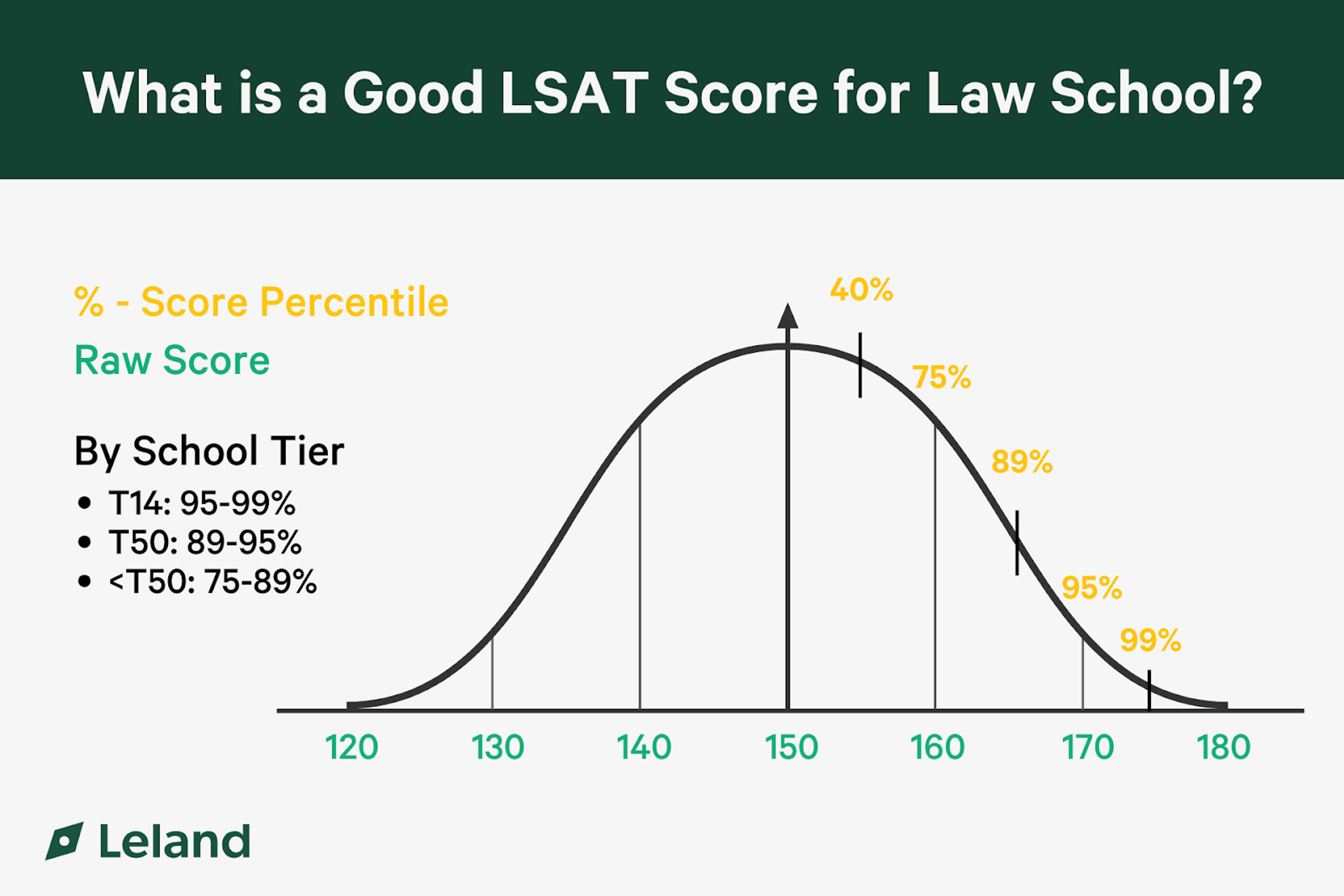LSAT Percentiles Explained (2025): Score Chart + Expert Admissions Advice
Understand LSAT percentiles with our 2025 score chart and expert admissions tips. See how your score compares and plan your law school strategy.

By Eshaan S.
99th Percentile Experienced Tutor w/ Proven Results!
Posted July 1, 2025

Join a free event
Learn from top coaches and industry experts in live, interactive sessions you can join for free.
Table of Contents
Your LSAT score plays a major role in law school admissions. But the raw score or scaled score alone doesn’t show how you compare to other applicants. That’s what the LSAT percentile is for. Your percentile rank tells you what percentage of test takers scored lower than you. For example, if you score a 160, you’re likely in the 75th percentile. That means 75% of test takers scored lower. Law schools use this information to see where you fall in their applicant pool and how your score compares to other students they’ve accepted.
Knowing your percentile helps you:
- Set score goals based on the schools you’re applying to
- Decide whether your current score makes you a competitive applicant for your target school, or if you should invest in retaking the test
- Understand how your score fits with each school’s reported medians and ranges
- Estimate your chances of getting scholarships, which typically go to applicants above a school’s median score
This guide breaks down how LSAT percentiles work, how the Law School Admission Council (LSAC) calculates them, and how you can use them to plan your next step, whether you’re applying soon or still preparing.

What Are LSAT Percentiles?
An LSAT percentile shows how your score compares to other test takers. This assessment helps law schools evaluate your competitive position among other applicants. It tells you the percentage of people who scored lower than you based on recent LSAT results. For example, if your scaled score is 165 and your percentile rank is 88%, that means you scored higher than 88% of test takers.
Law schools use percentiles to understand how strong a score is in the context of all test takers. While your raw score and scaled LSAT score show your individual performance on the exam, the percentile puts that score into perspective using historical data. Percentile ranks are based on scores from the past three LSAT testing years. The Law School Admission Council (LSAC) publishes this data and includes your percentile rank in your official score report.
Read: How Important is the LSAT for Law School Admission?
The Three LSAT Scores You’ll Receive
1. Raw Score
This is the number of questions you answered correctly out of the total number of scored questions (usually around 76–78). There’s no penalty for wrong answers. There is no failing score on the LSAT; it simply measures the number of questions you answered correctly. For example, if you answer 60 questions correctly, your raw score is 60.
2. Scaled LSAT Score
Your raw score is converted into a scaled score between 120 and 180. LSAC uses a process called equating to adjust for differences in difficulty across test versions. This scaled score is the number that law schools focus on most when reviewing applications. This scaled score is used by law schools to determine your likelihood of admission.
3. LSAT Score Percentile
Your LSAT percentile rank shows how your scaled score compares to other test takers. If your score is in the 93rd percentile, you performed better than 93% of LSAT takers from the past three testing years. Percentile data comes directly from the Law School Admission Council (LSAC).
LSAT Percentile Score Chart (2025 Update)
The charts below show how LSAT scaled scores correspond to percentile ranks, based on official data from the Law School Admission Council (LSAC) for the 2021–2024 testing years. These percentiles reflect how your score compares to others who took the LSAT during this period. For example, a scaled score of 160 places you in the 75th percentile, meaning you scored higher than 75% of test takers. A 170 puts you in the 96th percentile, while a 150 is around the 39th percentile.
Use this chart to understand how competitive your score is and how it aligns with the score ranges reported by law schools.
LSAT Percentile Table (2021–2024)
| Scaled Score | Percentile Rank (%) |
|---|---|
| 180 | 100 |
| 174-179 | 99 |
| 171-173 | 98 |
| 171 | 97 |
| 170 | 96 |
| 169 | 94 |
| 168 | 93 |
| 167 | 92 |
| 166 | 90 |
| 165 | 88 |
| 164 | 86 |
| 163 | 83 |
| 162 | 81 |
| 161 | 78 |
| 160 | 75 |
| 159 | 72 |
| 158 | 68 |
| 157 | 65 |
| 156 | 61 |
| 155 | 57 |
| 154 | 54 |
| 153 | 50 |
| 152 | 46 |
| 151 | 43 |
| 150 | 39 |
| 149 | 35 |
| 148 | 32 |
| 147 | 29 |
| 146 | 26 |
| 145 | 23 |
| 144 | 20 |
| 143 | 18 |
| 142 | 15 |
| 141 | 13 |
| 140 | 12 |
| 139 | 10 |
| 138 | 8 |
| 137 | 7 |
| 136 | 6 |
| 135 | 5 |
| 133-134 | 4 |
| 131-132 | 3 |
| 128-130 | 2 |
| 121-127 | 1 |
| 120 | 0 |
Percentile ranks are updated each year using historical data from the three most recent LSAT testing years. These ranks are used by law schools to evaluate applicants across different test dates and testing formats.
You can use this chart to:
- Benchmark your score against other applicants
- Compare your percentile to the 25th, 50th, and 75th percentile ranges at your target schools
- Decide whether a retake could help you reach a higher score band or improve your chances at merit scholarships
What Is a “Good” LSAT Score?
Deciding if your LSAT score is “good” depends on where you’re applying and your scholarship goals. Law schools have different score expectations based on selectivity, class profile goals, and applicant volume. The chart below shows how LSAT scores align with general admissions outcomes by school tier.
LSAT Score Ranges by Law School Tier
| Law School Tier | LSAT Score Range | Approx. Percentile | Target Schools Example |
|---|---|---|---|
| T14 (Top 14) | 170–180 | 95-99.9% | Yale, Harvard, Stanford, Columbia |
| Top 15–50 | 160–169 | 89-95% | Emory, Boston University, Fordham, UC Hastings |
| Regional / Mid-Tier | 150–159 | 75-89% | University of Baltimore, Drexel, DePaul |
| Access Law Schools | 140–149 | 50-75% | Charlotte School of Law, WMU Cooley, Southern U Law |
Median LSAT Scores at Top Law Schools
Most top-ranked law schools report median LSAT scores between 170 and 175. These medians represent the 50th percentile of their incoming class and are a strong indicator of admissions competitiveness.
| Law School | Median LSAT Score | Approx. Percentile |
|---|---|---|
| Harvard Law School | 174 | 99% |
| Yale Law School | 175 | 99% |
| Columbia Law School | 173 | 98% |
| NYU School of Law | 172 | 98% |
| University of Pennsylvania Law | 172 | 98% |
Note: If your LSAT score is below a school’s median, excellence in other parts of your application, like your undergraduate GPA, personal statement, and letters of recommendation, can help to improve your admissions chances. A score above the median may increase your odds of admission and can also improve your chances for scholarship offers.

How Law Schools Use LSAT Percentiles
Law schools use LSAT scores to compare law school applicants consistently. While admissions decisions also consider your undergraduate GPA, personal statement, letters of recommendation, and other parts of your application, your LSAT percentile helps schools quickly understand how your test score ranks against others. Most law schools publish the 25th, 50th (median), and 75th percentile LSAT scores for their incoming class. These percentiles help you estimate how your score compares to students who were recently admitted.
How to Read Law School Percentile Ranges
- 25th Percentile: Your score is lower than 75% of admitted students. The school may still admit you, but your GPA and other materials need to be strong. This school is a reach.
- 50th Percentile (Median): Your score is right in the middle. Half of the admitted students scored higher and half scored lower. This school is a target.
- 75th Percentile: Your score is higher than 75% of admitted students. You may have a stronger chance of admission and could qualify for merit aid. This school may be a safety, depending on other parts of your application.
Note: These ranges are updated every year and are based on actual LSAT score percentiles reported by the Law School Admission Council (LSAC). Comparing your score to these numbers can help you build a balanced and realistic school list.
How to Calculate Your LSAT Percentile
Step-by-Step Example
Let’s say you got 64 questions correct on a 76-question test. That’s your raw score.
- Using the score conversion chart, that might translate to a scaled LSAT score of 165.
- Based on LSAC data, that’s about the 88th percentile.
- Your score report will reflect this, showing your scaled score and percentile.
Expert Tip: Use historical data or your test provider’s tools to find your score band if you’re still in the LSAT prep stage.
LSAT Trends From Recent Years
- The average LSAT score remains close to 151, based on data from first-time test takers.
- A scaled score of 160 or higher places you in the top 20% of test takers and often improves your chances of admission or scholarship offers at competitive schools.
- As of August 2024, the LSAT format changed. The logic games section was removed and replaced with a second logical reasoning section. The test now includes:
- Two scored logical reasoning sections
- One scored reading comprehension section
- One unscored variable section
- The test now includes four scored sections: two logical reasoning sections, one reading comprehension section, and one unscored variable section.
Note: Despite the format update, the Law School Admission Council (LSAC) has stated that the change is not expected to affect scaled LSAT scores or percentile ranks. Schools will continue to interpret scores using the same scale and percentile data from recent years.
Expert Tips Based on Your LSAT Score Band
Score Lower Than 150
- Percentile Range: Below 40%
- Admissions Outlook: Competitive at access-focused law schools and conditional programs
What to do:
- Scoring below the 150s indicates unfamiliarity with foundational concepts and the skills tested by the LSAT
- Use analytics from timed practice tests to understand why you’re missing questions (e.g., time pressure, question type, fatigue). Then build your prep around those insights. Determining your weaknesses through analytics can help you focus your study efforts more effectively.
- Prioritize section-specific drills over full exams. At this stage, students typically display an overreliance on timed testing; drilling an untimed 1 LR/RC section enables you to check and improve your understanding without the pressure of a timer counting down.
- Retake only after identifying, drilling, and reviewing core issues. If you remain in a plateau with self-study, shift to a structured LSAT prep course or 1:1 tutoring focused on foundational logic and reading strategies.
- Typically, students I’ve worked with in this score range struggle with reading too fast or too slow. If you clarify what your goals are prior to approaching the stimulus/passage, your ability to accurately determine which information is relevant massively improves.
Score Between 150-159
- Percentile Range: ~40%–74%
- Admissions Outlook: Target range for many mid-tier and regional schools
What to do:
- Use LSAT percentiles to find strategic fits. Apply to schools where your score lands between their median and 75th percentile. This increases your chances of acceptance and puts you in a stronger position for review.
- Scholarships are possible—but not guaranteed. At schools where your score is above the 50th percentile, you may be considered for merit aid, especially if your GPA adds balance.
- Submit early in the cycle. Mid-range scores become less competitive later in the admissions season as more high-score applicants submit. Apply by October–November when possible.
- If you’re considering a retake, be tactical. Retake only if you’ve addressed your weak points and have tested 3+ points higher than your previous attempts, multiple times in a row. This ensures your potential score band (floor & ceiling) will be higher than your previous administration. Even small jumps can shift your percentile rank and change your admissions outlook.
Read: How Many Times Can You Take the LSAT? A Guide to LSAT Retakes
Score Between 160-169
- Percentile Range: ~75-95%
- Admissions Outlook: Strong position for T25-T50 schools
What to do:
- Maximize your score’s value by applying early. Many schools offer their largest merit packages to early applicants with LSAT scores at or above their 75th percentile. Your LSAT score is an important factor in admissions, so applying early can maximize its value.
- Stack softs with your score. Your score opens the door, but a strong undergraduate GPA, a standout personal statement, and professional experience can help you edge out similar applicants for limited seats or funding.
- Build a balanced school list. Apply to a mix of schools where your score is below the median (reach), at the median (target), and above it (likely admit/”safety”).
- Use your score as leverage. If multiple schools offer admission, use competing offers to negotiate or request reconsideration for scholarships.
Scored Between 170–180
- Percentile Range: 96%–99.9%
- Admissions Outlook: Competitive at T14 law schools, strong leverage for merit aid
What to do:
- Your score is an asset, use it to shape your strategy. Focus your school list on institutions where your score is at or above the 75th percentile. This can lead to high scholarship offers and reduce total debt.
- Achieving the highest LSAT score possible can significantly enhance your admissions prospects and scholarship opportunities.
- Don’t rush your personal statement. At this level, many applicants look the same on paper. Your essays need to show personality, purpose, and clarity, without trying to impress with vocabulary or legal clichés.
- Match the quality of your letters of recommendation to your score. Ask recommenders to speak to analytical strength, leadership, and resilience—qualities that show you’re more than a strong test taker.
- Submit before peak volume. T14 schools tend to get the most applications between November and January. Submitting by mid-October puts you in a smaller, more favorable pool.
The Bottom Line
Your LSAT percentile gives law schools context for your score, showing not just what you scored, but how you performed compared to other applicants. Whether you’re aiming for a T14 school or building a balanced school list, understanding where your score falls in the percentile rankings can help you plan more effectively. Use this data to guide your next steps: whether that’s retaking the exam, adjusting your target schools, or focusing on strengthening other parts of your application. Even small improvements in your scaled score can move you up several points in the percentile ranking, which may increase your chances of admission and scholarship offers.
Get LSAT Help From Coach
Struggling with the LSAT or stuck at the same score? Eshaan S. is a 99th percentile LSAT tutor who helps students improve fast with clear strategies and one-on-one support. He’s helped students score as high as 175 and loves working with people who feel like the test is just out of reach. Book time with Eshaan or send a message.
Read Next:
- What is the LSAT Out Of & What's a Good Score? (2025)
- LSAT Reading Comprehension Guide: Tips, Strategies, & Practice
- Law Schools That Don't Require the LSAT: Exploring Your Options
- How to Improve Your Evaluation Skills for the LSAT
- 10 Ways to Strengthen Your LSAT Reading Comprehension
- LSAT vs. GRE for Law School–Which to Take and How to Ace Both
- Top 30+ Free Resources for the LSAT
FAQs About LSAT Percentiles
How rare is a 177 LSAT?
- A 177 LSAT score places you in approximately the 99.5th percentile, based on LSAC data from 2021–2024. That means fewer than 1 out of every 200 test takers reach this score. It is considered extremely competitive and is well above the 75th percentile at nearly all law schools, including the T14.
How rare is a 175 LSAT?
- A 175 LSAT score is around the 99th percentile, meaning you scored higher than 99% of all test takers. This score is common among applicants admitted to schools like Yale, Harvard, and Stanford, but still represents only a small percentage of LSAT takers each year.
What percentile is 165 on the LSAT?
- A scaled score of 165 is in the 88th percentile, according to LSAC’s official data. This puts you ahead of most test takers and makes you competitive for many Top 30–50 law schools, especially when paired with a strong undergraduate GPA and application materials.

Written by Eshaan
4.8
(20)
Eshaan has helped clients get into organizations like:
Browse hundreds of expert coaches
Leland coaches have helped thousands of people achieve their goals. A dedicated mentor can make all the difference.















